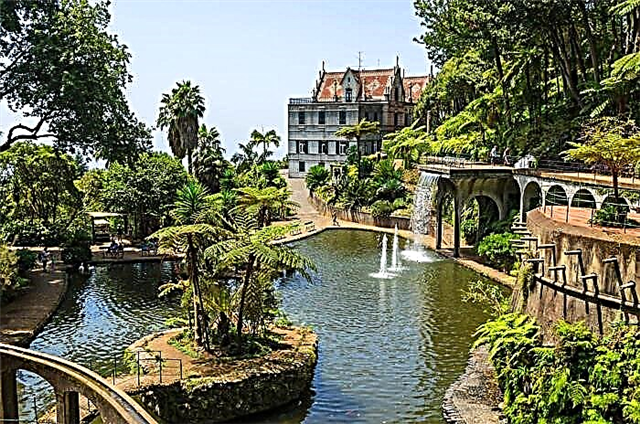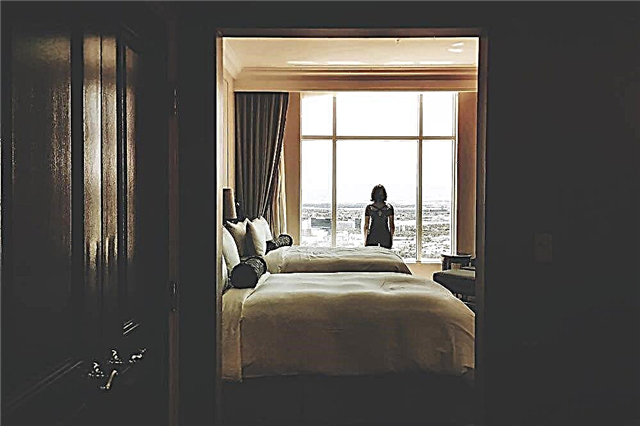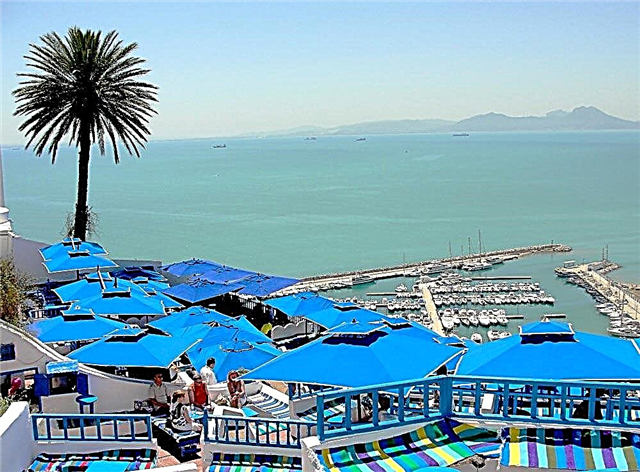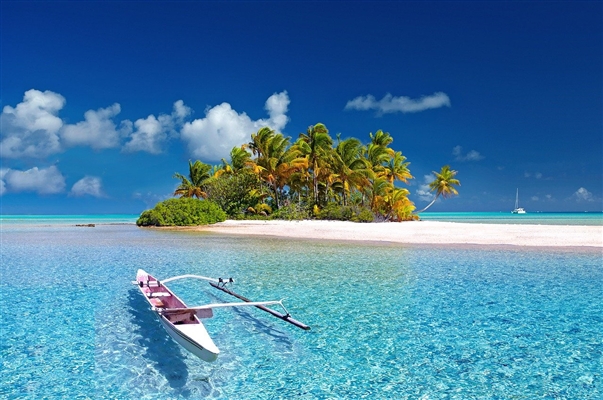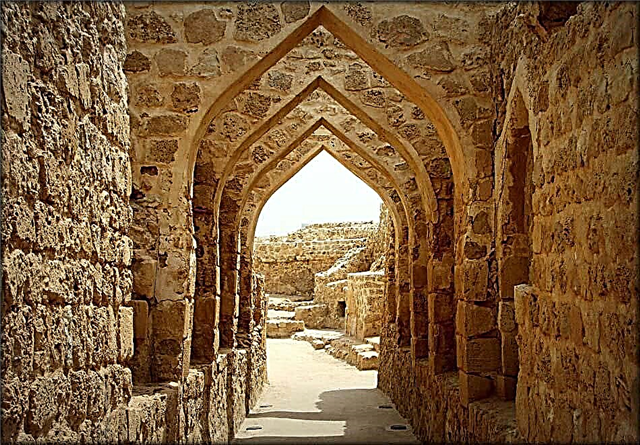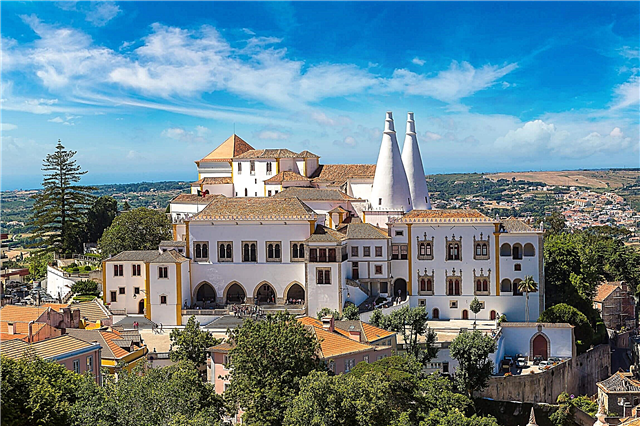Portugal is a country with an ancient culture and history, a chronicle in stone is an impressive number of palaces that were the residences of monarchs and rulers. They were created in different historical periods, each of them is a reflection of some page in the history of the Portuguese land. Some palaces have been rebuilt over the centuries, so you can observe a mixture of styles of architecture in one building.
Many palaces of architectural monuments are concentrated in Lisbon, Sintra, and in the vicinity of these cities. Some palaces are located at a considerable distance from the capital, and you need to travel around the country to see them. Many palaces were built during the reign of kings, but there are also relatively recent ones. The decoration often used azulejo tiles in the traditional azure range.
The most beautiful palace complexes in Portugal
List, photos with titles and descriptions!
Sintra National Palace
White in color, with an unusual silhouette due to tall chimneys, it is visible from afar. Located in the center of Sintra. Completed many times, this is noticeable in the mixture of architectural styles. From the 15th to the end of the 19th century, monarchs lived here. Several notable rooms in the center of the palace: the Hall of Arms, Hall of Forty with a drawing of many forty on the ceiling, the Swan Hall with a painted ceiling in a swan theme. The earliest construction of the ensemble is the palace chapel.

Pena Palace
The story began with a chapel on the hill in honor of the Holy Virgin Mary, now only the altar has survived. The construction of the palace began in 1838 for Ferdinand II. In architecture, deliberate mixing of styles by order of the king. Inside there are 10 halls with furniture and interiors of that era, in the palace kitchen - dishes with the emblem of the king. An impressive park with an area of 240 hectares, with ponds and exotic plants. Panoramic views of Lisbon, Sintra and the Moorish Castle. The museum has been open since 1910.

Queluz
Luxurious building in the Rococo style - a summer royal residence, located in the vicinity of Lisbon. Construction began in 1747 and completed half a century later. The park, with its garden and fountain, was the entertainment place for the royal family. Decorating the palace in gentle colors, statues in the park brought from England and Italy. The interior features national features of decoration, using azulejo tiles and mosaics on the windows. Since 1908 it has been the property of the state, a museum since 1940.

Mafra
The most impressive one, located in the suburbs of the capital, houses a library of 35 thousand ancient works. Built in 1730, in honor of the birth of the first-born son of King João V and Anne of Austria. In the mature baroque style, with a dynamic alternation of convex-concave shapes. The grandiose ensemble includes: a rectangular basilica, a library, a Franciscan monastery. The opulent halls of the palace were used for receptions and ceremonies.

Quinta da Regaleira
Built relatively recently, this is the most mysterious place in Sintra. Gothic Revival style. The current appearance was created thanks to the patron of the arts, Carvalho Monteiro, who was related to Freemasonry, as evidenced by the half-hidden elements of the architecture of the building and the park. The park has a chapel, fountains, grottoes and other architectural delights full of mysterious meaning. The well of Initiation with an inverted tower deserves special attention. Since 1995 it has been a World Heritage Site.

Montserrat
The complex with a romantic park is an architectural monument of the 19th century, located on the outskirts of Sintra. Over 5 centuries of history, many owners have changed and it acquired its current appearance thanks to the Briton Francis Cook. In 1858, Cook built a new palace and redesigned the park. Park on 33 hectares, it contains plants from all over the world. The palace itself is luxurious, with an organic interweaving of different styles: Gothic, Moorish and Indian. Acquired by the state in 1949.

Ajuda
The royal building is located in Lisbon. Built on the site of the palace destroyed by the 1755 earthquake. The construction began in the Baroque style, and with the change of the architect, the style changed to neoclassical. The royal family has lived there since 1861. Now it is a functioning national palace, important state receptions and events are held there. Open to tourists since 1968, the interior of the 18th - 19th centuries with furniture, sculptures and ceramics remained here.

Belensky Palace
Official residence of the President of Portugal with a waving green flag and the national coat of arms. The palace is located in Lisbon. This building saved the life of King Jose I and his family during the earthquake of 1755; the building was not damaged at all. This place was traditionally intended for the residence of the rulers and the reception of distinguished guests. The building is unusual, of different heights, built in 1559 on the banks of the Tagus River.

Bishop's Palace in Braga
Located near the Cathedral, the history of the building dates back to 1330. The palace was founded by Archbishop Gonçalo Pereira. The building was completed over several centuries, but retained its original appearance. Consists of 3 buildings. The oldest library in the country, archives and university administration are located here. The large library contains unique manuscripts and 300 thousand valuable books. The beautiful garden of St. Barbara is adjacent to the palace.

Sao Bento
It also has another name: the Palace of the National Assembly. Located in the center of Lisbon. It was built in the 17th century as a monastery estate. It was rebuilt many times, changing the appearance and style of architecture. In 1834 it was transferred to the state. It is now a government building where the Portuguese parliament regularly meets. The wide square in front of the palace is the traditional venue for demonstrations and rallies.
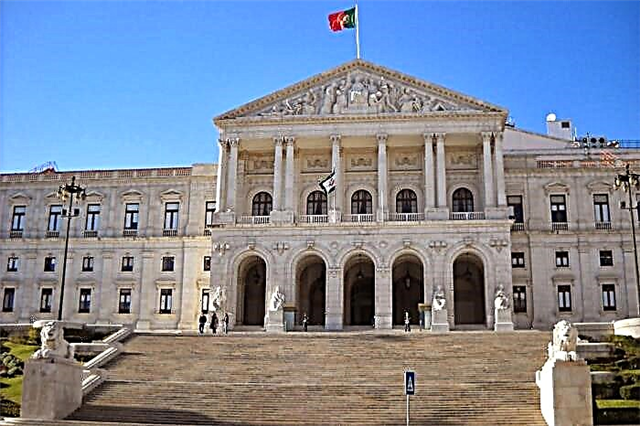
Pasu Dukal
The Marble Palace is located in the town of Vila-Visosa, built in 1501. To decorate the palace, in 1537, the production of local marble was specially opened and now there is a museum with an abandoned adit. The building belonged to the possessions of Duke Fernando Braganza. On the square in front of the palace, there is a sculpture of the Duke of Bragan VIII, who later became king and made a great contribution to the development of the region.

Palace of the Dukes of Bragança
The building is rectangular in shape and impressive in size, located opposite the chapel of São Miguel do Castelo. There are 39 brick chimneys on the roof and 4 watchtowers along the perimeter of the large courtyard. Built at the beginning of the 15th century, it was the residence of the Duke of Braganza. After restoration in the middle of the 20th century, it became a museum with a unique collection of Flemish tapestries, weapons, Persian carpets and porcelain. This is the official residence of the President of Portugal during his visits.

Stock Exchange Palace
It is located in the center of Porto, next to the Church of St. Francis on the site of a monastery damaged in a fire in 1832. Queen Mary II donated these lands to merchants for the construction of a commercial building. It was built in 1850 and finished for another 60 years. The building is modest on the outside, but magnificent on the inside, several halls are noteworthy: the Hall of Nations with a glass dome and the coats of arms of trading partners located along the perimeter, the Golden Hall, the Portrait Hall and the most magnificent Arabian Hall.

Palace of the Marquis Fronteira
Country residence built in 1670 in the Renaissance style. Located in Lisbon. It has been the property of one family for 13 generations, now the descendants of the Marquis of Fronteira live there. The building and garden are full of details. The palace looks like a painted box, everywhere in the decor - azulejo tiles with traditional blue glaze. You can see several rooms, sometimes shown by the current owner.

Episcopal Palace in Porto
Located on a hill in Porto, next to the Cathedral. Rectangular in shape with a large courtyard.Built in the XII-XIII century, it was completed many times. In 1387, there was the wedding of King João I and the British princess Philip of Lancaster. Baroque and neoclassical interior. Until the end of the 19th century, it was the seat of the bishops of Porto, where inaugurations took place. Now it is the property of the state for celebrations and receptions.

Mateusz
Located in the town of the same name, next to Vila Real. It was created in the late Baroque style in 1740 on the site of the count's house of Antonio Joe by Botel Murana. Until now, this is the property of the descendants of the graph. The facade of the palace is lavishly decorated, with many graceful details. Accurate geometric shapes are observed. There is a park, a well-groomed garden with flowers, shrubs and a cypress alley. A very high chapel is built nearby.

King Manuel's palace
Built in Evora on the site of the San Francisco convent in 1490. It was restored and completed many times, this was reflected in the mixing of styles: neo-Moorish, gothic, manueline. For a long time it was the residence of kings. Important events took place here: the wedding of Prince Afonso and Isabella, the appointment of Vasco da Gama as commander for a trip to India. Survived 2 fires with loss of interior and destruction. Only the gallery has survived. A park was built on the site of the destroyed part.

Raiu
Built in 1775, located in the city of Braga. Created in the Baroque style, and the interior is in the Rococo style. The walls of the façade are lavishly decorated with azulejo tiles with a traditional azure glaze color. A beautiful roof with a balustrade and gabled turrets. In 1867, it was acquired by the entrepreneur Miguel Raju, since that time the palace bears his name. Later, a new owner appeared - the Order of Mercy and the Hospital of St. Mark was organized in the complex.

Foch
Located in the center of Lisbon on Rashtauradores Square. Since 1869, the building has been the residence of the Marquis Foch, hence the name of the palace. The complex took a long time to build, from the mid-18th to the mid-19th centuries. In architecture, styles are mixed: the era of the Italian Renaissance and the Baroque of the 17th century. The façade is decorated with frescoes, the interior is in a rich Versailles style. At the beginning of the twentieth century, theatrical performances took place there. The building now houses the National Tourism and Information Office.

Monte
Located in the autonomous region of Portugal, on the island of Madeira. Built in the 18th century and retained its original appearance. Around the Garden of Eden with an area of 70 thousand square meters, with exotic plants and animals from all over the world. In the 19th century, the palace was converted into a hotel where famous guests came to rest. Now it is a museum with an exhibition of unique sculptures and a rare collection of minerals from all over the world. The palace's observation deck offers stunning views of Funchal and the Atlantic Ocean.
